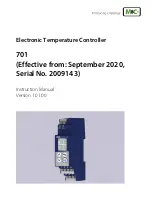
685 Series
ComboPak
User’s Manua
l · Page 25
point or two point calibration and apply the calibration to your voltage input. The
instrument will measure actual current flowing, so turn the output on with the
current set point at 0mA, apply a modulation input signal, and the instrument will
measure the actual current, which you can use to calibrate your voltage set
point.
When modulating at higher frequencies (>1 kHz), it is critical that high quality,
shielded twisted pair cabling be used, and wire size suitable for the applied
current (or the equivalent if using a multi-conductor cable). See the chart below
for suggested sizes. Failure to do so may result in current oscillations that may
damage your laser. When operating in these modes, always use shielded cable
and never use individual wires to connect the instrument to your laser. If in
doubt, use a current probe attached to an oscilloscope to monitor actual
performance.
The
1220B
or
1221B
cables recommended by Arroyo Instruments are shielded
twisted pair, and will provide good modulation performance.
Current (A) Recommend Wire Gauge
1 or less
24 AWG
2
22 AWG
Compensating for Voltage Loss
All cables and connectors have a small, but measurable, resistance. When
driving current through them, this resistance causes a voltage loss in the cable,
and if not compensated for, will result in errors in laser or LED voltage
measurement. In many cases, this is not a problem, as highly accurate voltage
measurement are typically not required and the error can be ignored. However,
if accurate voltage measurements are required, the
ComboPak
offers two
methods to compensate for this loss: the
Cable R
setting and remote voltage
sense.
Cable R
compensation is software only, so it requires no special wiring
to implement. Remote voltage sense, on the other hand, does require additional
wiring, but is the most accurate method. Details on both are found below.
Using Remote Voltage Sense
The
ComboPak
supports remote (4-wire type) voltage measurement of the laser
diode, providing a higher accuracy voltage measurement by directly measuring
voltage at the diode itself. While the
Cable R
setting described below can
provide some of the same benefits of remote voltage sense, remote voltage
sense is a superior method, and remote voltage sense differs from the
Cable R
method in a few key ways:
1.
No need to calculate cable resistance
2.
Voltage measurement is accurate even if the cable resistance changes
















































